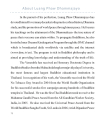Buddhist precepts : ค้นหาหนังสือธรรมะ หน้า 4 / 4
หน้าหนังสือทั้งหมด

126
Understanding Nibbana and Key Buddhist Concepts
Nibbana (Skt. Nirvana): the state of ultimate happiness, the happy condition of enlightenment, the highest spiritual attainment. This is not the sense-based happiness of the everyday livid; nor is it
Nibbana, or Nirvana, represents the ultimate happiness in Buddhism, transcending ordinary joy and marking the end of the rebirth cycle. It's a state of perfect enlightenment that goes beyond language,

36
Understanding Novice Ordination in Buddhism
7. Abstaining from singing and dancing and other activities that may lead you to temptation
8. Abstaining from immodest dressing and appearance
9. Abstaining from indolent sleeping habits
10. Abstaini
Ordination in Buddhism is a significant ritual that marks the commitment of individuals to follow the teachings of the Buddha. The ten precepts outlined offer a moral framework for novices, highlighti

58
Luang Phaw Dhammajayo: A Journey of Buddhist Leadership
Luang Phaw Dhammajayo (The Most Venerable
Dhammajayo Bhikkhu) was born in Singburi Province,
Central Thailand, on April 22, 1944. He has followed
and been self-educated in Buddhism since his
childhood
Luang Phaw Dhammajayo, born on April 22, 1944, in Singburi, Thailand, is a distinguished Buddhist monk and the founder of Dhammakaya Temple. After earning his Economics degree from Kasetsart Universit

76
Luang Phaw Dhammajayo: A Beacon of Peace and Buddhism
About Luang Phaw Dhammajayo
In the pursuit of his perfection, Luang Phaw Dhammajayo has
devoted himselfovermany decadestothepracticeofmeditation, Dhamma
study, and the promotion of world peace through
Luang Phaw Dhammajayo has spent decades dedicated to meditation and Dhamma study, promoting world peace through inner peace. His teachings focus on attaining the Dhammakaya, the true nature of peace a

7
Exploring Buddhist Meditation and Its Significance
Preface
Not a month goes by these days without another important article being published on some newly uncovered Buddhist text, and among the discoveries are ancient materials about Buddhist meditati
This preface discusses the ongoing discoveries in Buddhist meditation texts and the efforts of Venerable Phrakrupaladnayokwarawat (Sudhammo Bhikkhu) in promoting scholarly exploration. It emphasizes t

16
Launch of the Journal of the Dhammachai International Research Institute
Introduction
This collection of articles marks the launch of the Journal of the Dhammachai International Research Institute (JDIRI). The articles presented here indicate some of the perspectives on B
This collection of articles marks the launch of the JDIRI, showcasing perspectives on Early Buddhism and meditation studies. The journal aims to publish research on ancient manuscripts and esoteric pr

32
Dhamma-kāya in the Pali Canon
Dhamma-kāya in the Pali Canon¹
Chanida Jantrasrisalai
I. Why ‘Dhamma-kāya’ in the ‘Pali Canon’?
The term dhamma-kāya/dharmakāya appears in Buddhist literature of different schools. Previous scholars
The study investigates the term dhamma-kāya as presented in the Pali Canon, aiming to provide a comprehensive analysis that has been overlooked in previous studies. While many references have been mad

34
Understanding Dhammakāya in Early Buddhist Thought
II. The Different Approach
A fairly established academic understanding has settled regarding the term dhammakāya in the Pali canon, that it was used merely in the sense of the ‘Buddha’s teachings.’ In
The term 'dhammakāya' in the Pali canon is understood as representing the Buddha's teachings. It is established through several canonical passages that equate the Buddha with dhamma. Notable reference

91
Exploration of Theravāda Buddhist Manuscripts in Sipsong Panna
literature.9 It is notable that the Agama Sutras (阿含经) discovered in the Xishuangbanna region are incomplete. For example, the Hinayana Agama should have contained the Khuddaka Patha (小品), Dharma-phra
The Agama Sutras found in the Xishuangbanna region are notable for their incompleteness. The Hinayana Agama is expected to contain various texts that are partly missing. According to The Complete Coll

121
The Influence of An Shigao on Mindfulness Breathing Meditation in Eastern Han China
In this paper I explore the connections between An Shigao and the introduction of the Indian Buddhist meditation technique of mindfulness breathing meditation, or ānāpānasmṛti, into Eastern Han China.
This paper examines An Shigao's role in introducing the Indian mindfulness breathing meditation technique, ānāpānasmṛti, into Eastern Han China. The phrase「息中具有四大。 而心在中」suggests that the mind should f

156
A ‘New’ Early Chinese Buddhist Commentary
Zacchetti, Stefano. 2008 "A ‘New’ Early Chinese Buddhist Commentary: The Nature of the Da Anban Shouyi Jing (T 602) Reconsidered." Journal of the International Association of Buddhist Studies 31: 421-
This research article by Stefano Zacchetti delves into the nature of the Da Anban Shouyi Jing (T 602), reconsidering its significance in early Chinese Buddhist commentary. The study provides insights

9
Buddhist Unity and Harmony: Insights from Most Ven. Dhammapriya Mahathero
Digest from speech of Most Ven. Dhammapriya Mahathero Abbot, Mahananda Sangharaj Vihara
Vice President of the Supreme Sangha Council of Bangladesh
Founder of Dhamapriya Buddhist Welfare Mission, Kolka
In a profound address, Most Ven. Dhammapriya Mahathero emphasizes the interconnectedness of all beings, portraying them as part of one family, deriving from shared karmic categories. He urges the prop

63
Charumati Buddha Vihar and Buddhist Mission in Nepal
Charumati Buddha Vihar and resident of Charumati Buddhist mission Nepal / วัด จารุมาติวิหาร ประเทศเนปาล
๒๖. โโล่งวัดและใบประกาศเกียรติคุณ จาก Prof. Dr. Mitomo Kenyo / ค.ศ. มิโดเมะ เกนโญ พระมหาเกระระด
Charumati Buddha Vihar in Nepal is notable for its contributions to Buddhism and its recognition with various honors from esteemed Buddhist figures worldwide. This includes accolades from Prof. Dr. Mi

33
Exploring Buddhist Texts and Influence
Bernhard, Franz.
1970 "Gåndhārī and the Buddhist Mission in Central Asia." Ánjali: Papers on Indology and Buddhism: A Felicitation Volume Presented to Oliver Hector de Alwis Wijesekera on His Sixtieth
This collection of works explores the significant contributions to Buddhist scholarship, including analyses of the Gåndhārī texts, the investigation of the Därșanatika, and the characteristics of the

8
The Significance of Ordination in Thai Buddhism
Thailand is a Buddhist Society. A large part of our culture stems from Buddhist heritage. Our forefathers handed down to us through the generations, a lasting legacy of humble thought and traditions d
Thailand is deeply rooted in Buddhist culture, with a legacy that promotes moral values. The process of ordination allows individuals to elevate their consciousness and become part of the Buddhist com

6
Creating Harmony in the Family
Part Three Harmony in the Family
157
Chapter 15 Creating Harmony in the Family
159
Chapter 16 What Should Parents Do When Their Children
Do Not Get Along?
165
Chapter 32 Teaching Children to Live by t
Part Three of the book focuses on creating harmony in the family and the roles of parents in ensuring a peaceful and loving environment. Topics include what parents should do when their children do no

86
The Five Precepts of Buddhism
THE FIVE PRECEPTS
The Five Precepts consist of the following:
1. Not to kill living beings (including animals)
2. Not to steal
3. Not to commit sexual misconduct
4. Not to tell lies
5. Not to consume
The Five Precepts in Buddhism outline ethical guidelines for practitioners, emphasizing respect for life among other moral behaviors. The First Precept, which prohibits killing, is noted as the graves

92
Understanding the Importance of the Fifth and Eight Precepts
- Loss of consciousness and sanity
Those who have made a serious breach of this precept will end up in hell or other unhappy realm. As humans, they will be born with mental illnesses, be retarded or
The text discusses the severe consequences of violating the Fifth Precept in Buddhism, leading to unhappiness and potential mental disorders in future lives. It emphasizes the benefits of adhering to

67
Be a Good Role Model for Children
Be a good role model for
the children to observe
The first factor is the most difficult because many parents
do not realize how influential they are to their children. Before
we can begin to be good r
บทความนี้เน้นให้พ่อแม่เห็นความสำคัญของการเป็นตัวอย่างที่ดีให้กับลูก โดยการรักษาคุณธรรมและปฏิบัติตามศีลห้า เพราะเด็กมีพฤติกรรมที่เรียนรู้จากผู้ปกครอง หากพ่อแม่ไม่สามารถรักษาคุณธรรมในชีวิตประจำวันได้ ลู

88
Building a Unified Community: The Four Bases of Social Solidarity
If parents behave appropriately toward their neighbors,
they will be loved and respected. Then it may be appropriate
for them to remind their neighbors of the neighbors' behavior.
The Lord Buddha taug
The text discusses the importance of parents' behavior towards their neighbors, emphasizing Buddha's Four Bases of Social Solidarity: Generosity, Kind Speech, Useful Conduct, and Even Treatment. It hi
